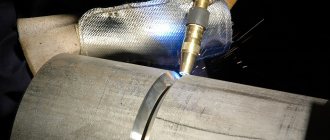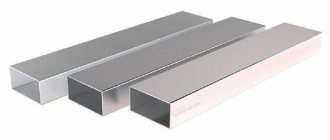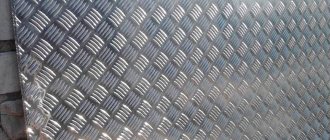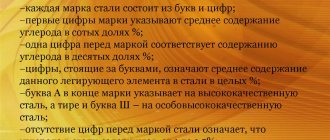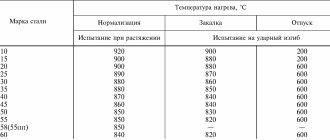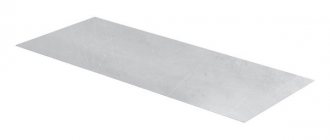1 area of use
This standard applies to hot-rolled and forged (diameter, square side or thickness up to 200 mm inclusive), calibrated metal products and metal products with special surface finishing made from stainless steels and iron-nickel-based alloys that are corrosion-resistant, heat-resistant and heat-resistant.
Hot-rolled and forged metal products with a diameter, square side or thickness over 200 to 350 mm inclusive are manufactured by agreement between the manufacturer and the customer.
5Order conditions
The customer must provide the manufacturer with all requirements necessary for the supply of metal products in accordance with the requirements of this standard.
5.1 Basic requirements specified when placing an order:
- scope of delivery;
-method of production of metal products (hot-rolled, forged, calibrated, with special surface finishing);
- cross-sectional shape (circle, square, hexagon, strip), dimensions of metal products and designation of the corresponding standard assortment;
-type of delivery (in rods, in coils, in strips);
- designation of this standard;
-grade of steel or alloy;
-method of smelting, remelting and casting steel or alloy;
- quality or surface finishing group;
- state of delivery or type of heat treatment;
- document on the quality of metal products in accordance with GOST 7566.
_______________
See also [2].
5.2 Additional requirements specified when placing an order, taking into account requirements 7.2.
2 Normative references
This standard uses normative references to the following interstate standards:
GOST 103-2006 Long-rolled hot-rolled steel strip. Assortment
GOST 166-89 (ISO 3599-76) Calipers. Specifications
GOST 427-75 Metal measuring rulers. Specifications
GOST 1051-73 Calibrated rolled products. General technical conditions
GOST 1133-71 Forged steel round and square. Assortment
GOST 1497-84 (ISO 6892-84) Metals. Tensile test methods
GOST 1778-70 (ISO 4967-79) Steel. Metallographic methods for determining non-metallic inclusions1)
___________
1) In the Russian Federation, GOST R ISO 4967-2009 (ISO 4967:1998) “Steel. Determination of the content of non-metallic inclusions. Metallographic method using standard scales."
GOST 2216-84 Smooth adjustable clamp gauges. Specifications
GOST 2246-70 Steel welding wire. Specifications
GOST 2590-2006 Hot-rolled round steel products. Assortment
GOST 2591-2006 Hot-rolled square steel products. Assortment
GOST 2879-2006 Hot-rolled hexagonal long steel products. Assortment
GOST 4405-75 Hot-rolled and forged strips made of tool steel. Assortment
GOST 5632-2014 Alloyed stainless steels and alloys are corrosion-resistant, heat-resistant and heat-resistant. Brands2)
___________
2) In the Russian Federation, when manufacturing metal products for nuclear power engineering enterprises, until December 31, 2022, it is necessary to be guided by GOST 5632-72 “High-alloy steels and corrosion-resistant, heat-resistant and heat-resistant alloys. Stamps."
GOST 5639-82 Steels and alloys. Methods for identifying and determining grain size
GOST 6032-2017 (ISO 3651-1:1998, ISO 3651-2:1998) Corrosion-resistant steels and alloys. Test methods for resistance to intergranular corrosion
GOST 6507-90 Micrometers. Specifications
GOST 7417-75 Calibrated round steel. Assortment
GOST 7502-98 Metal measuring tapes. Specifications
GOST 7564-97 Rental. General rules for sampling, blanks and specimens for mechanical and technological tests
GOST 7565-81 (ISO 377-2-89) Cast iron, steel and alloys. Sampling method for determining chemical composition1)
___________
1) In the Russian Federation, GOST R ISO 14284-2009 “Steel and cast iron. Selection and preparation of samples to determine the chemical composition."
GOST 7566-94 Metal products. Reception, labeling, packaging, transportation and storage2)
___________
2) Replaced by GOST 7566-2018 “Metal products. Acceptance rules, labeling, packaging, transportation and storage.”
GOST 8559-75 Calibrated square steel. Assortment
GOST 8560-78 Calibrated hexagonal rolled products. Assortment
GOST 8817-82 Metals. Slump test method
GOST 9012-59 (ISO 410-82, ISO 6506-81) Metals. Brinell hardness measurement method
GOST 9013-59 (ISO 6508-86) Metals. Rockwell hardness test method
GOST 9454-78 Metals. Impact bending test method at low, room and elevated temperatures
GOST 9651-84 (ISO 783-89) Metals. Tensile test methods at elevated temperatures
GOST 10145-81 Metals. Long-term strength test method
GOST 10243-75 Steel. Test methods and macrostructure evaluation
GOST 11098-75 Staples with a reading device. Specifications
GOST 11878-66 Austenitic steel. Methods for determining the ferrite phase content in rods
GOST 12344-2003 Alloy and high-alloy steels. Carbon determination methods
GOST 12345-2001 (ISO 671-82, ISO 4935-89) Alloy and high-alloy steels. Methods for determining sulfur
GOST 12346-78 (ISO 439-82, ISO 4829-1-86) Alloy and high-alloy steels. Methods for determining silicon
GOST 12347-77 Alloy and high-alloy steels. Phosphorus determination methods
GOST 12348-78 (ISO 629-82) Alloy and high-alloy steels. Methods for determining manganese
GOST 12349-83 Alloy and high-alloy steels. Methods for determining tungsten
GOST 12350-78 Alloy and high-alloy steels. Methods for determining chromium
GOST 12351-2003 (ISO 4942:1988, ISO 9647:1989) Alloy and high-alloy steels. Methods for determining vanadium
GOST 12352-81 Alloy and high-alloy steels. Methods for determining nickel
GOST 12353-78 Alloy and high-alloy steels. Methods for determining cobalt
GOST 12354-81 Alloy and high-alloy steels. Methods for determining molybdenum
GOST 12355-78 Alloy and high-alloy steels. Methods for determining copper
GOST 12356-81 Alloy and high-alloy steels. Methods for determining titanium
GOST 12357-84 Alloy and high-alloy steels. Methods for determining aluminum
GOST 12358-2002 Alloy and high-alloy steels. Arsenic determination methods
GOST 12359-99 (ISO 4945-77) Carbon steels, alloyed and high-alloyed. Methods for determining nitrogen
GOST 12360-82 Alloy and high-alloy steels. Methods for determining boron3)
___________
3) In the Russian Federation, GOST R ISO 10153-2011 “Steel. Determination of boron content. Spectrophotometric method using curcumin."
GOST 12361-2002 Alloy and high-alloy steels. Methods for determining niobium
GOST 12362-79 Alloy and high-alloy steels. Methods for determining microimpurities of antimony, lead, tin, zinc and cadmium
GOST 12363-79 Alloy and high-alloy steels. Methods for determining selenium
GOST 12364-84 Alloy and high-alloy steels. Methods for determining cerium
GOST 12365-84 Alloy and high-alloy steels. Methods for determining zirconium
GOST 14955-77 High-quality round steel with special surface finishing. Specifications
GOST 15846-2002 Products sent to the Far North and equivalent areas. Packaging, labeling, transportation and storage
GOST 17745-90 Steels and alloys. Gas determination methods
GOST 18895-97 Steel. Photoelectric spectral analysis method1)
___________
1) In the Russian Federation, GOST R 54153-2010 “Steel. Method of atomic emission spectral analysis".
GOST 24597-81 Packages of packaged piece goods. Main parameters and dimensions
GOST 26663-85 Transport packages. Formation using packaging tools. General technical requirements
GOST 27809-95 Cast iron and steel. Spectrographic analysis methods
GOST 28033-89 Steel. X-ray fluorescence analysis method
GOST 28473-90 Cast iron, steel, ferroalloys, chrome, manganese metal. General requirements for analysis methods
Note - When using this standard, it is advisable to check the validity of the reference standards in the public information system - on the official website of the Federal Agency for Technical Regulation and Metrology on the Internet or using the annual information index "National Standards", which was published as of January 1 of the current year, and on issues of the monthly information index “National Standards” for the current year. If the reference standard is replaced (changed), then when using this standard you should be guided by the replacing (changed) standard. If the reference standard is canceled without replacement, then the provision in which a reference is made to it is applied in the part that does not affect this reference.
Preface
Preface
The goals, basic principles and basic procedure for carrying out work on interstate standardization are established in GOST 1.0-2015 “Interstate standardization system. Basic provisions" and GOST 1.2-2015 "Interstate standardization system. Interstate standards, rules and recommendations for interstate standardization. Rules for the development, adoption, updating of the Central Scientific Research Institute of Ferrous Metallurgy named after I.P. Bardin (FSUE TsNIIchermet named after I.P. Bardin)
2INTRODUCED by the Federal Agency for Technical Regulation and Metrology
3ADOPTED by the Interstate Council for Standardization, Metrology and Certification (protocol dated June 27, 2022 N 53)
Voted for adoption:
| Brief name of the country according to MK (ISO 3166)004-97 | Country code according to MK (ISO 3166) 004-97 | Abbreviated name of the national standardization body |
| Belarus | BY | State Standard of the Republic of Belarus |
| Kyrgyzstan | KG | Kyrgyzstandard |
| Kazakhstan | KZ | State Standard of the Republic of Kazakhstan |
| Russia | RU | Rosstandart |
| Tajikistan | T.J. | Tajikstandard |
| Uzbekistan | UZ | Uzstandard |
| Ukraine | U.A. | Ministry of Economic Development of Ukraine |
4 By order of the Federal Agency for Technical Regulation and Metrology dated September 20, 2022 N624-st, the interstate standard GOST 5949-2018 was introduced as a national standard of the Russian Federation from February 1, 2022.
5INstead of GOST 5949-75
Information about
changes to this standard is published in the annual information index “ National Standards ” , and the text of changes and amendments is published in the monthly information index “ National Standards ” . In case of revision (replacement) or cancellation of this standard corresponding notice will be published in the monthly information index “ National Standards ” . Relevant information, notices and texts also posted in public information system - on the official website the Federal Agency for Technical Regulation and Metrology on the Internet ( www . gost . ru )
ASSORTMENT
2.1. Hot rolled thin sheets are produced with a thickness of 1.5 to 3.9 mm, cold rolled - with a thickness of 0.5 to 3.9 mm. (Changed edition, Amendment No. 2).
2.2. The shape, dimensions and maximum deviations in dimensions of thin-sheet rolled products must comply with the requirements: - hot-rolled - GOST 19903; — cold rolled — GOST 19904.
2.3. Deviation from flatness of sheets with a temporary resistance of 70 kgf/mm less must comply with GOST 19903 and GOST 19904 for high (PV), improved (PU) and normal (PN) flatness. Deviation from flatness of sheets with temporary resistance St. 70 to 85 kgf/mm incl. should not exceed 25 mm per 1 m of length. Notes:
1. Deviation from flatness of hot-rolled steel supplied in a heat-treated state without pickling is not standardized.
2. Longitudinal uniform bending (curvature that copies the shape of the roll - roll curvature) of cold-worked and semi-work-hardened rolled products cut from rolls is not a defective feature. (Changed edition, Amendment No. 2).
Examples of symbols
Hot-rolled sheets of normal accuracy (B), improved flatness (PU), with uncut edge (NO), size 3x710x1420 mm according to GOST 19903, made of steel grade 20X13, heat-treated, pickled, surface group M3b:
Cold-rolled sheets, increased precision: thickness (AT), width (AS), length (AD), normal flatness (PN), with cut edge (O), size 2x1000x2000 mm according to GOST 19904, made of steel grade 12Х18Н10Т, cold-worked:
Cold-rolled sheets, normal accuracy: thickness (BT), width (BS), length (BD), normal flat (PN), with cut edge (O), size 1.2x1100x2300 mm according to GOST 19904, made of steel grade 08Х13, heat-treated, etched, surface group M2a:
(Changed edition, Amendment No. 4).
Manufacturing by profiling
In cases where square or rectangular stainless pipes are required in small volumes, it makes no sense to purchase expensive full-cycle equipment for their production. It is possible to produce such pipes, which will also meet all GOST requirements, by profiling round pipe blanks.
Along with the advantages of this technology, namely that its use requires less initial investment and can be implemented even in a small room, its use also has a big disadvantage. It lies in the fact that profile stainless steel pipes produced using this technology are more expensive than welded products.
Forming machine shapes round tube into square or rectangular shape
Considering the fact that the vast majority of both square and rectangular pipes made of stainless steel are not used in cases where high tightness is required from them, it is better to use inexpensive profile pipes obtained using welding.
How to bend stainless pipes
When bending such products, it is important to prevent changes in the original cross-sectional configuration and the formation of creases on their inner surface. Deformation will weaken the load-bearing capacity of such a part, reduce its throughput, and increase the likelihood of corrosion.
In industrial conditions, bending of stainless steel pipes is carried out in the following ways:
- Run-in.
- Winding.
- Rolling.
- Drawing.
- Hydrostatic.
- By pushing.
- Using two supports.
Such pipe bending technologies allow you to obtain high-quality results, but require special equipment.
At home, you can bend a stainless steel profile using a manual pipe bender. In this case, to support the walls from the inside, the following is used:
- Clean dry sand and two plugs. First, one of the plugs is installed. Then the pipe at the future bend is filled with sand through the free end, carefully compacted and clogged with another plug. Next, the pipe is bent around a blank of the required size.
- A bundle of wire. The pipe cavity is filled to capacity with pieces of thick wire. After bending, the wire is removed one by one.
- A spring of the appropriate shape. It should be wound from wire 2–4 mm thick in such a shape that it fits freely into the cavity of the pipe at the bend. At the end of bending, the spring is removed using a wire previously left outside.
To bend a profile with a significant bending radius, the walls are preheated with a blowtorch or gas torch. Heated metal bends more easily.
Installation Tips
When assembling metal structures from stainless steel profile pipes, the parts are connected by welding or fastening with clamps. The elements can be fixed using electric arc, gas or resistance welding.
When arc welding, it is important to choose the right electrode. The quality of the weld depends on its diameter. If it is too thin, the welding process will be interrupted; if the electrode cross-section is too large, a thin-walled pipe can be burned.
Electric arc welding should not be performed in open areas. Such work is carried out in special premises. In this case, the ends of the parts to be welded must first be cleaned and degreased.
The contact type of welding forms a welding seam of increased reliability. There are no restrictions on ambient temperature and other weather conditions for its use.
General recommendations for carrying out any type of welding are as follows:
- When choosing a welding temperature, you should proceed from the thickness of the metal, since profile products are more susceptible to deformation than round ones.
- To maintain the internal clearance of the profile, it is necessary to prevent molten metal from entering the stainless steel profile pipe.
- When performing welding, it is necessary to carefully check the geometric coincidence of the ends of the parts being welded so that distortions do not occur in the metal structure.
Alternative to profile pipes
The use of profile stainless pipes is not always technically and economically feasible. It's not cheap. In addition, it cannot be used for laying pipelines transporting liquid and gaseous media under high pressure. This is especially true for electric-welded products with a seam: due to the presence of different angles inside such pipelines, blockages can quickly form at the bends. For the installation of such communications, only round pipes are used. And it doesn't have to be stainless steel.
Modern pipe products made of reinforced polypropylene are not inferior in a number of technical characteristics to stainless steel, but are much cheaper. Profiles made of plastic are more often used as ventilation ducts. They are available in white, so they fit more harmoniously into the interior of kitchens and bathrooms.
An alternative option for constructing a chimney could be a galvanized sandwich pipe. Galvanized steel is just as fire-resistant and fireproof as stainless steel, but is less resistant to corrosion from condensation. But the price of galvanized sandwich chimneys is much lower, as is the cost of installation. And in order to slow down the corrosive destruction of the metal, the surfaces of the chimney are coated with a special heat-resistant paint for galvanizing.
Aluminum pipes are also of good quality. They are lightweight, corrosion-resistant, and are a good option for making indoor decorative elements, furniture parts and other lightly loaded structures.
Features of operation
Structures made from profile stainless steel pipes do not lose their load-bearing capacity and presentable appearance over time. They do not need painting and can be easily washed with household chemicals that do not contain chlorine. Dried stains cannot be scraped off or removed with a wire brush: use only a soft cloth or foam sponges.
Possible problems
In some cases, rolled stainless steel may be subject to corrosion. Foci of rust appear on the walls of products after prolonged contact with a concentrated chlorine solution. To eliminate the cause of corrosion, it is necessary to thoroughly rinse off the chlorine-rich liquid. The rusting process of stainless steel parts will slow down, and they will retain their anti-corrosion properties.
Packaging, transportation and storage
For ease of transportation, profiled stainless steel pipes are bundled or tightly placed in wooden containers lined with waterproof paper. The packages are tied with wire or metal tape in three or four places depending on the weight. For strapping during loading and unloading operations, bags and containers are equipped with special clamps.
They can be transported by any type of transport. The packages are placed on the floor of the car or in the body of the car in stacks, separating the rows with spacers.
Profile stainless steel products are stored on racks in closed warehouses or under a canopy, where they will be protected from atmospheric moisture.
Standard sizes and markings
Marking of profile stainless steel products is applied to their outer side at the factory after manufacturing. It consists of information about the standard size of the product, as well as the steel grade and the manufacturer’s trademark.
For example, let’s decipher the marking 100×100x5 09G2S:
- The first two positions indicate the size of the ribs in mm. In this case, 100 mm and 100 mm, since the pipe has a square profile.
- The third is the thickness of the walls.
- The fourth is the steel grade (set if necessary).
TECHNICAL REQUIREMENTS
3.1. Rolled products are produced in the following grades: 11Х11Н2В2МФ, 16Х11Н2В2МФ, 20Х13, 30Х13, 40Х13, 09Х16Н4Б, 12Х13, 14Х17Н2, 08Х13, 12Х17, 08Х17Т, 08Х18Тч, 08Х18Т1, 1 5Х25Т, 15Х28, 20Х13Н4Г9, 09Х15Н8У1, 07Х16Н6, 08Х17Н5М3, 20Х20Н14С2, 08Х22Н6Т, 12Х21Н5Т, 08Х21Н6М2Т , 20Х23Н13, 15Х18Н12С4ТУ, 10Х11Н20Т2Р, 10Х13Г18Д, 10Х14Г14Н4Т, 10Х14AG15, 12Х17Г9АN4, 03Х17Н14М3, 10Х17Н13М2Т, 10Х17Н13М3Т, 0 8Х17Н15М3Т, 12Х18Н9, 17Х18Н9, 08Х18Н10, 08Х18Н10Т, 12Х18Н10Т, 12Х18Н10Э, 03Х18Н11, 03Х18Н12-VI, 08Х18Н12Т, 08Х18Н12Б, 03Х21Н21 M4GB, 20Х23Н18, 20Х25Н20С2 , 12X25N16G7AR, 06XN28MT, 06XN28MDT.
3.2. The chemical composition of steels is in accordance with GOST 5632. Notes:
1. In steel grade 12Х21Н5Т, deviations in titanium content are not allowed. With the consent of the consumer, sheets can be produced with maximum deviations for titanium in accordance with GOST 5632.
2. For steel grade 12Х18Н10Т, rolled on continuous and semi-continuous mills, the titanium content should be [5 (C - 0.02) - 0.7]%, and the ratio of chromium to nickel content should not exceed 1.8.
3.1, 3.2. (Changed edition, Amendment No. 2).
3.3. The macrostructure of the steel should not have traces of shrinkage cavities, delaminations, foreign inclusions, cracks and bubbles and is ensured by the manufacturing technology. There should be no cracks, splits or delaminations in the sheet cuts.
3.4. The mechanical properties of rolled products subjected to heat treatment (softening) must comply with the standards specified in Table 1.
Table 1
| steel grade | Heat treatment mode for sheets (recommended) | Tensile strength, N/mm(kgf/mm) | Yield strength, N/mm(kgf/mm) | Relative extension, , % |
| no less | ||||
| 11Х11Н2В2МФ | Annealing 760−780 °C | No more than 830 (85) | — | 22 |
| 16Х11Н2В2МФ | ||||
| 20Х13 | Annealing or tempering 740−800 °C | 490 (50) | 20 | |
| 30Х13 | 540 (55) | 17 | ||
| 40Х13 | 550 (56) | 15 | ||
| 09Х16Н4Б | Annealing 620−640 °C, holding for 4−8 hours, cooling with a furnace to 200−300 °C, then in air | No more than 1130 (115) | — | |
| 12Х13 | Annealing or tempering 740−780 °C | 440 (45) | 21 | |
| 14Х17Н2 | Annealing or tempering 650−700 °C | By agreement | ||
| 08Х13 | Annealing or tempering 740−780 °C | 410 (42) | — | 21 |
| 12Х17 | 490 (50) | 20 | ||
| 08Х17Т | Annealing or tempering 740−780 °C | 460 (47) | 20 | |
| Annealing 830−860 °C, cooling in air or normalization at 960−1000 °C, cooling in air or water | 460 (47) | 30 | ||
| 08Х18Тч | Hardening 920 °C, cooling in water | 470 (48) | 35 | |
| 08Х18Т1 | Annealing 830−860 °C, cooling in air or normalization 960−1000 °C, cooling in air or water | 460 (47) | 30 | |
| 15Х25Т | Annealing or tempering 740−780 °C | 530 (54) | 17 | |
| 20Х13Н4Г9 | Quenching 1050−1080 °C, cooling in water or air | 640 (65) | 40 | |
| 15Х28 | Annealing or tempering 740−780 °C | 530 (54) | 17 | |
| 09Х15Н8У1 | Normalization 1040−1080 °C | No more than 1080 (110) | 20 | |
| 07Х16Н6 | Quenching 1030−1070 °C, cooling in water or air | No more than 1180 (120) | 20 | |
| 08Х17Н5М3 | Quenching 1030−1080 °C, cooling in air or water | No more than 1180 (120) | 610 (62) | 20 |
| 20Х20Н14С2 | Quenching 1000−1080 °C, cooling in air or water | 590 (60) | — | 40 |
| 08Х22Н6Т | Quenching 950−1050 °C, cooling in water or air | 640 (65) | 20 | |
| 12Х21Н5Т | Quenching 1000−1080 °C, cooling in water or air | 690 (70) | 440 (45) | 18 |
| 08Х21Н6М2Т | 590 (60) | — | 22 | |
| 20Х23Н13 | Quenching 1100−1150 °C, cooling in water or air | 540 (55) | 35 | |
| 15Х18Н12С4ТУ | Quenching 1020−1050 °C, cooling in water | 720 (73) | 345 (35) | 30* |
| 10Х11Н20Т2Р | Quenching 1020−1060 °C, cooling in water or air | No more than 740 (75) | — | |
| 10Х14Г14Н4Т | Quenching 1050−1080 °C, cooling in water | 690 (70) | 295 (30) | 35 |
| 10X14AG15 | Quenching 950−1100 °C, cooling in water | 740 (975) | — | 45 |
| 12X17G9AN4 | Quenching 1050−1080 °C, cooling in water or air | 690 (70) | 40 | |
| 03Х17Н14М3 | Quenching 1030−1070 °C, cooling in water or air | 490 (50) | 196 (20) | |
| 10Х17Н13М2Т | Quenching 1050−1080 °C, cooling in water or air | 530 (54) | 225 (23) | 38 |
| 10Х17Н13М3Т | — | |||
| 08Х17Н15М3Т | 205 (21) | 35 | ||
| 12Х18Н9 | 540 (55) | 195 (20) | 38 | |
| 17Х18Н9 | 590 (60) | — | 35 | |
| 08Х18Н10 | 510 (52) | 185 (19) | 45 | |
| 08Х18Н10Т | 530 (54) | 205 (21) | 40 | |
| 12Х18Н10Т | 205 (21) | |||
| 12Х18Н10Э | No more than 740 (75) | — | 35 | |
| 03Х18Н11 | 490 (50) | 196 (20) | ||
| 03Х18Н12-VI | 390 (40) | — | 40 | |
| 08Х18Н12Т | 510 (52) | 35 | ||
| 08Х18Н12Б | 530 (54) | 40 | ||
| 03Х21Н21М4ГБ | Quenching 1080−1130 °C, cooling in water or air | 540 (55) | 245 (25) | 25** |
| 20Х23Н18 | Quenching 1080−1150 °C, cooling in water or air | 510 (52) | 35 | |
| 20Х25Н20С2 | Quenching 1050−1100 °C, cooling in water or air | 490 (50) | — | |
| 12X25N16G7AR | No more than 980 (100) | |||
| 06ХН28МТ | Quenching 1050−1080 °C, cooling in water or air | 540 (55) | ||
| 06ХН28МДТ | 540 (55) | |||
___________________ * Relative extension . ** Relative extension . Notes:
1. The table shows the recommended mode and type of heat treatment at the manufacturer.
2. By agreement between the consumer and the manufacturer, changes in the mode and type of heat treatment are allowed.
3. For hot-rolled steel grades 20Х13, 30Х13, 40Х13, 08Х17Т, 12Х13, 14Х17Н2, 08Х13, 12Х17, 08Х18Т1, 15Х25Т, 15Х28, it is allowed not to perform heat treatment when obtaining the mechanical properties indicated in Table 1.
4−6. Excluded. By agreement between the manufacturer and the consumer, rolled steel grades 08Х18Т1, 10Х17Н13М2Т, 10Х17Н13М3Т, 08Х18Н10Т, 12Х18Н10Т, 20Х23Н18 are manufactured with increased values of mechanical properties indicated in Table 1a.
Table 1a
| steel grade | Heat treatment mode for sheets (recommended) | Tensile strength, N/mm(kgf/mm) | Yield strength, N/mm(kgf/mm) | Relative extension, , % |
| no less | ||||
| 08Х18Т1 | Annealing 830−860 °C, cooling in air or normalization 960−1000 °C, cooling in air or water | 490 (50) | — | 32 |
| 10Х17Н13М2Т | Quenching 1050−1080 °C, cooling in water or air | 550 (56) | — | 40 |
| 10Х17Н13М3Т | ||||
| 08Х18Н10Т | 216 (22) | 42 | ||
| 12Х18Н10Т | ||||
| 20Х23Н18 | Quenching 1080−1150 °C, cooling in water or air | 530 (54) | — | 37 |
(Changed edition, Amendment No. 1−4).
3.5. The mechanical properties of cold-worked and semi-work-hardened steel must comply with the standards specified in Table 2.
table 2
| steel grade | Delivery status | Tensile strength, N/mm(kgf/mm) | Yield strength, N/mm(kgf/mm) | Relative extension, , % |
| No less | ||||
| 20Х13Н4Г9 | Hardened | At least 980 (100) | — | 15 |
| 15Х18Н12С4ТУ | At least 880 (90) | 685 (70) | 10 | |
| 12X17G9AN4 | At least 980 (100) | — | 15 | |
| 12Х18Н9 | 930−1230 (95−125) | 13 | ||
| 17Х18Н9 | 980−1230 (100−125) | |||
| 17Х18Н9 | Semi-hardened | 740−980 (75−100) | 18 | |
| 08Х18Н10 | 740−930 (75−95) | 25 | ||
| 08Х18Н10 | Hardened | At least 930 (95) | 10 | |
| 12Х18Н10Т | Semi-hardened | At least 740 (75) | 25 | |
| 12Х18Н10Т | Hardened | 880−1080 (90−110) | 10 | |
| 03Х18Н12-VI | Semi-hardened | At least 740 (75) | 12 | |
Notes:
1. Excluded.
2. By agreement between the consumer and the manufacturer, heat treatment may be used to ensure the properties specified in Table 2. (Changed edition, Amendment No. 2).
3.6. The mechanical properties of rolled products, determined on control heat-treated samples, must comply with the standards specified in Table 3.
3.7. The mechanical properties of rolled steel grades 12Kh18N10T, 12Kh25N16G7AR and 10Kh11N20T2R, determined at the request of the consumer at elevated temperatures on heat-treated samples, must comply with the standards specified in Table. 4.
Table 3
| steel grade | Sample thermal treatment mode (recommended) | Tensile strength, N/mm(kgf/mm) | Yield strength, N/mm(kgf/mm) | Relative extension, , % |
| no less | ||||
| 11Х11Н2В2МФ | Quenching 1000−1150 °C, air cooling, tempering 560−600 °C, air cooling | 880 (90) | — | 10 |
| 16Х11Н2В2МФ | Quenching 960−1000 °C, air cooling, tempering 240−400 °C, air cooling | 1320 (135) | ||
| 09Х16Н4Б | Quenching 970−1050 °C, air cooling, tempering 300−350 °C, holding 2 hours, air cooling | 1230 (125) | 8 | |
| 14Х17Н2 | Quenching 950−975 °C, cooling in oil, tempering 275−350 °C, air cooling | 1080 (110) | 10 | |
| 07Х16Н6 | Quenching 960−990 °C, air cooling, cold treatment at -70 °C for 2 hours, tempering 350−400 °C, holding for 1 hour, air cooling | 835 (85) | 12 | |
| 08Х17Н5М3 | Quenching (940±10) °C, cooling in air or water, cold treatment at -70 °C for 2 hours, tempering (450±10) °C, holding for 1 hour, cooling in air | 1180 (120) | 885 (90) | 9 |
| 10Х11Н20Т2Р | Hardening 1020−1060 °C, cooling in water or air, aging (720±10) °C, holding 4−12 hours, cooling in air | 960 (98) | — | 20 |
(Changed edition, Amendment No. 2).
Table 4
| steel grade | Heat treatment mode | Test temperature, °C | Tensile strength, N/mm(kgf/mm) | Relative extension, , % |
| no less | ||||
| 12Х18Н10Т | Quenching 1050−1080 °C, cooling in water or air | 700 | 250 (25) | 40 |
| 12X25N16G7AR | Quenching 1050−1100 °C, cooling in water or air | 900 | 180 (18) | 30 |
| 10Х11Н20Т2Р | Hardening 1020−1060 °C, cooling in water or air, aging (720±10) °C, holding for 8 hours, cooling in air | 700 | 590 (60) | 10 |
Note. Steel is hardened in sheets. (Changed edition, Amendment No. 2).
3.8. In terms of type and surface quality, rolled products must meet the requirements specified in Table 5.
Table 5
| Surface group | Material condition | Surface description | Name of allowed surface defects | Maximum depth of permissible defects |
| 1 | Cold-worked (N) and semi-hardened (PN) | Shiny without blistering bubbles, rolled out bubbles, captivity, rolled-in metal particles, ripples and over-etching, with a slight difference in shades | Scratches, dents, prints, marks, rolled out prints | sums of maximum deviations in thickness |
| 2 | a) Cold rolled, heat treated, pickled or after bright annealing | Silver-matte or shiny, without blistering bubbles, rolled out bubbles, captivity, rolled-in metal particles, scale and over-etching | Ripple, scratches, prints, dents, marks, rolled out prints | |
| b) Hot rolled, heat treated, pickled or after bright annealing | Ripple, scratches, prints, dents, scratches, cavities, rolled out prints | |||
| 3 | a) Cold rolled, heat treated, pickled or after bright annealing | Ripple, scratches, prints, dents, marks, rolled out prints | Sum of maximum deviations in thickness | |
| b) Hot rolled, heat treated, pickled or after bright annealing | Ripple, scratches, prints, dents, scratches, cavities, rolled out prints | |||
| 4 | a) Cold rolled, heat treated, pickled or after bright annealing | Silver-matte or shiny without blistering bubbles, rolled bubbles, scale and over-etching | Ripple, scratches, prints, dents, risks, rolled films, rolled prints | |
| b) Hot rolled, heat treated, pickled or after bright annealing | Ripple, scratches, prints, dents, scratches, cavities, rolled prints, rolled films | |||
| c) Cold rolled, heat treated | Dark | Ripple, scratches, prints, dents, scratches, rolled films, rolled prints, scale | ||
| d) Hot rolled, heat treated | Ripple, scratches, prints, dents, scratches, cavities, rolled films, rolled prints, scale |
Notes:
1. Requirements for the surface quality of heat-treated rolled products in terms of the number and nature of defects can be specified by agreement between the consumer and the manufacturer using standards.
2. Gentle grinding of surface defects is allowed with abrasive with a grain size in accordance with GOST 3647, no larger than N 16 for groups 1 and 2 and with a grain size no larger than N 25 for groups 3 and 4 to a depth that does not take the rolled product beyond the minimum thickness. Arson from clean-up operations is not permitted.
3. At the consumer’s request, rental products are manufactured without cleaning or cutting out unacceptable defects.
4. Colors of tarnish and various shades from pickling on cold-rolled and hot-rolled, heat-treated steel by pickling or after bright annealing are not a defective sign. (Changed edition, Amendment No. 2, 4).
3.9. Steel grades 20Х13Н4Г9, 09Х15Н8У1, 08Х22Н6Т, 08Х21Н6М2Т, 10Х14Г14Н4Т, 12Х17Н14МЗ, 10Х17Н13М2Т, 10Х17Н13МЗТ, 08Х17Н15МЗТ, 12Х18Н9, 08Х18Н10, 08Х18Н10Т, 12Х18Н10Т, 12Х18Н10Э, 03Х18Н11, 03Х18Н12-VI, 08Х18Н12Т, 08Х18Н12Б, 03Х21Н21М4ГБ, 06ХН28МДТ and 06ХН 28MT should not have prone to intergranular corrosion.
3.10. At the consumer's request, sheets are produced:
a) with checking steel grade 12Х21Н5Т for lack of tendency to embrittlement, the heat treatment regime and standards must correspond to those indicated in Table 6.
Table 6
| Sample thermal treatment mode | Sheet thickness, mm | Increment of temporary resistance, %, no more | Impact strength kgf m/cm, not less |
| Heating to 550 °C, holding for 1 hour, cooling in an oven (at a rate of 100 °C/h) to 300 °C, then cooling in air | Up to 2 | 50,0* | — |
| 2 or more | — | 4,0 |
_______________ * The increment in tensile strength after tempering is determined as a percentage of the tensile strength of heat-treated soft rolled products.
b) with normalized surface roughness of cold-worked and semi-work-hardened steel;
c) with normalization of the gas content in steel grade 03Х18Н12-VI, which should not exceed: oxygen - 0.006%, nitrogen - 0.03%;
d) without mechanical tests and other tests provided for by this standard;
e) with the determination of mechanical properties at elevated temperatures for steel grades not listed in Table 4;
f) with the determination of the yield strength for steel grades, the norms of the yield strength of which are not given in Table 1;
g) with bending test;
h) with bending test;
i) with a spherical hole drawing test;
j) with the determination of the alpha phase in austenitic and austenitic-ferritic steels;
k) with checking for the absence of steel’s tendency to intergranular corrosion for steel grades not specified in GOST 6032*; ______________ * GOST 6032–2003 is in force on the territory of the Russian Federation, hereinafter in the text. — Note from the database manufacturer.
l) with checking for the absence of steel’s tendency to intergranular corrosion for steel grades 08Х17Т, 15Х25Т, 07Х16Н6, 08Х17Н5М3;
m) with control of internal defects using non-destructive testing methods. Note. Test methods for subparagraphs k, l, n, as well as test standards for subparagraphs b, d, e-n are established by agreement between the consumer and the manufacturer. (Changed edition, Amendment No. 1).
6Assortment
In terms of shape, size and maximum deviations, metal products must comply with:
a) hot rolled:
1) round in rods and coils - GOST 2590 or other regulatory documents agreed upon when placing an order;
2) square in rods and coils - GOST 2591 or other regulatory documents agreed upon when placing the order;
3) hexagonal in rods and coils - GOST 2879 or other regulatory documents agreed upon when placing an order;
4) strip - GOST 103, GOST 4405 or other regulatory documents agreed upon when placing an order;
b) forged:
1) round and square rolled - GOST 1133 or other regulatory documents agreed upon when placing an order;
2) strip - GOST 4405 or other regulatory documents agreed upon when placing an order;
c) calibrated:
1) round in rods and coils - GOST 7417;
2) square in rods and coils - GOST 8559;
3) hexagonal in rods and coils - GOST 8560;
4) strip - regulatory documents agreed upon when placing an order;
d) with special surface finishing in rods and coils - GOST 14955.
